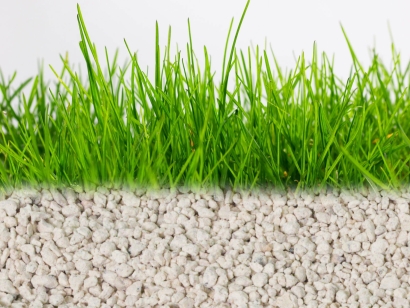
If you ask a professional artificial grass installer if you need an infill, he'd likely say "Yes." But don't forget; artificial grass installation is aka any other home renovation; it isn't a task to delegate; it's a task to manage. You need to ask questions all the way through to the end. For most people, artificial grass installation without infill is easier, quicker and less expensive; at first glance synthetic turf looks great without an infill, and you may wonder why do you need it at all.
After you roll out the turf during artificial grass installation, you nail and staple it down around the perimeter and seems. While it may sound good enough to keep the turf in place, over time, you may notice wrinkles and sagging across the area. That's when you think of infill. Infills add weight to artificial grass. In other words, it gives the entire system stability. Infill is a ballast; it maintains balance and steadiness.
Artificial grass is made of nylon or polypropylene synthetic fibers that have different degrees of resiliency and a softer polyethylene thatch; the backing supports the turf blades bounce back after pressure applied.
There are also artificial grass synthetic fiber shapes which determine the turf resilience, or its ability to bounce back to its original shape. Walking on turf flattens its fibers, making the lawn look a bit "off."
When you add an infill, it helps blades stand upright.
The infill provides a cushioning effect; more infill you add, softer the turf feels under the feet. The infill level in low to medium traffic areas doesn't drop as quickly, as on athletic fields, but if you feel you turf surface is getting harder, you may redistribute the existing layer of the infill with a rake and add more infill when needed.
Infill protects the backing system of artificial grass. The backing system supports the structure of turf; it's durable by default, but infill supplements its protection from UV radiation and foot traffic extending the lifespan of your artificial grass lawn.
Infill depth doesn't affect surface hardness under dry conditions. But when it's wet, added infill lowers the hardness values and results in better GMax index. Finer sands measured higher in surface hardness than coarser sands. According to studies, the 38 mm infill depth had lower GMax values than the 25 mm infill depth.
Specific types of artificial grass infill contain natural proteins used as an antimicrobial flocculant for water clarification. Infill with antimicrobial properties kill bacteria that can cause a range of diseases and prevent pet odor from becoming an issue.

Infill gives you the feel of walking on real grass by emulating the impact absorption qualities of soil. The infill is spread as a layer underneath the artificial grass blades, enabling the blades to stand up straight and gives a lawn a particular feel. Sand infill, for example, makes turf firm underfoot.
There are the things that may add unnecessary costs to your artificial grass installation, but infill is not one of them. If you install synthetic turf outdoor, infill is the most practical solution for you; it helps lawn look realistic, adds extra protection, deters bacteria, and expands the lifespan of your dazzling lawn transformation.